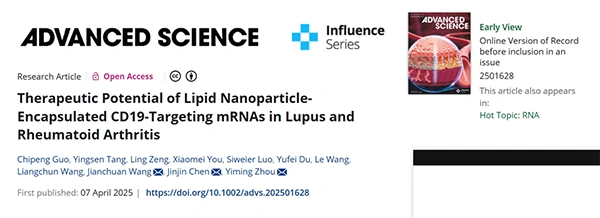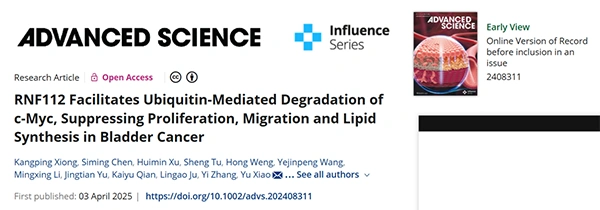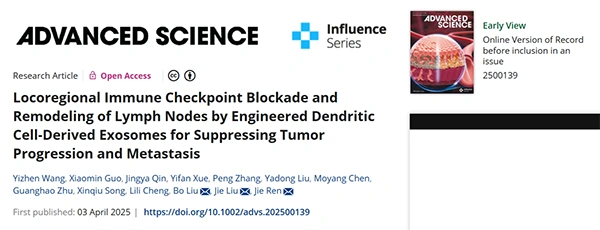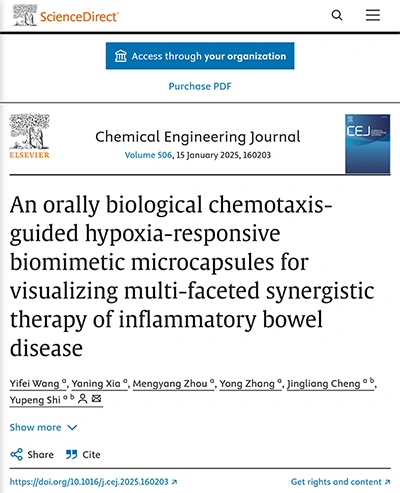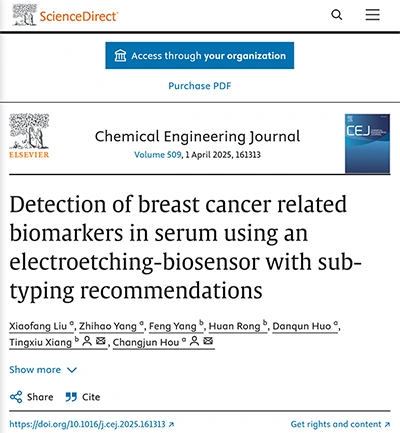Thank you for your continued support of CUSABIO! In May 2025, articles related to CUSABIO products were published in excess of 240, with a cumulative impact factor exceeding 1200. The total number of articles has now reached 26,800.
Thank you for choosing CUSABIO research products on your scientific research journey. Your trust and support are deeply appreciated. We will continue to work hard to provide you with even better products and services.
Now, let's take a moment to share these wonderful research results.
CUSABIO Monthly Citation Review
02 RNF112 Facilitates Ubiquitin‐Mediated Degradation of c‐Myc, Suppressing Proliferation, Migration and Lipid Synthesis in Bladder Cancer
Impact Factor: 14.3
Journal Name: Advanced Science
CUSABIO Citation Product:
Recombinant Human Glutathione S-transferase A1 (GSTA1); CSB-EP009970HU
Recombinant Human RING finger protein 112 (RNF112); CSB-CF019818HU
Research Highlights:
This study found that the E3 ubiquitin ligase RNF112 is significantly downregulated in bladder cancer and associated with disease progression. In vitro and in vivo experiments showed that RNF112 directly interacts with the MB II domain of c-Myc through its N-terminal zinc finger motif, and its catalytic site C97 facilitates K48-linked polyubiquitination of the K389 residue on the c-Myc protein, accelerating its degradation. Additionally, c-Myc binds to the promoter of ATP citrate lyase (ACLY), a key enzyme in lipid metabolism, promoting its transcriptional activity. Restoring c-Myc or ACLY expression attenuated the inhibitory effects of RNF112 on bladder cancer cell growth, migration, and lipid synthesis. The study suggests that targeting the RNF112/c-Myc/ACLY axis could be a promising therapeutic strategy for bladder cancer.
03 Locoregional Immune Checkpoint Blockade and Remodeling of Lymph Nodes by Engineered Dendritic Cell‐Derived Exosomes for Suppressing Tumor Progression and Metastasis
Impact Factor: 14.3
Journal Name: Advanced Science
CUSABIO Citation Product:
Mouse Interferon β,IFN-β/IFNB ELISA Kit; CSB-E04945m
Mouse Interferon γ,IFN-γ ELISA Kit; CSB-E04578m
Mouse Tumor necrosis factor α,TNF-α ELISA KIT; CSB-E04741m
Mouse interleukin 12,IL-12/P40 ELISA KIT; CSB-E07360m
Research Highlights:
This study developed engineered dendritic cell-derived exosomes (EmDEX@GA) for locoregional immunomodulation of tumor-draining lymph nodes (TDLNs). EmDEX@GA possess CCR7-dependent LN targeting and over-expressed PD-1 for immune checkpoint blockade, while loaded with a STING agonist to enhance anti-tumor immunity. In an orthotopic breast cancer mouse model, intratumoral injection of EmDEX@GA remodeled the immunosuppressive microenvironment of TDLNs, significantly suppressing tumor growth and both lymph node and distant metastasis. It outperformed systemic ICB therapy, with the best efficacy achieved via low-dose cycle administration. The study also revealed that the immune microenvironment of TDLNs, rather than their metastatic status, is closely associated with distant metastasis. This work offers a novel local strategy for tumor immunotherapy, potentially improving prognosis.
04 Calpain‐2‐Mediated Endothelial Focal Adhesion Disruption in Thoracic Aortic Dissection
Impact Factor: 14.3
Journal Name: Advanced Science
CUSABIO Citation Product:
Human alpha II-spectrin breakdown product SBDP145 ELISA kit; CSB-EQ028022HU
Research Highlights:
This study uncovers the abnormal changes in endothelial focal adhesion during the early stages of thoracic aortic dissection (TAD). Through single-cell RNA sequencing of patient samples, it was found that dysregulated Calpain-2 expression modulates endothelial focal adhesion proteins, serving as an early pathological hallmark and driver of TAD. Elevated plasma calpain activity is strongly associated with an increased risk of TAD and organ dysfunction. Both endogenous and exogenous calpain inhibitors effectively prevent TAD onset and progression in mouse models. Further research revealed that angiotensin II upregulates Calpain-2, leading to endothelial focal adhesion activation through talin1 cleavage and Itgav assembly, thereby compromising endothelial integrity and permeability. Additionally, endothelial-specific deletion of Capns1 mitigates early and sustained endothelial focal adhesion damage, reducing TAD incidence, while macrophage-specific Capns1 knockout does not impact TAD development but accelerates aortic dissection rupture in later stages. These findings identify potential therapeutic targets for TAD prevention and treatment.
05 Fragment Autoantigens Stimulated T‐Cell‐Immunotherapy (FAST) as a Fast Autologous Cancer Vaccine
Impact Factor: 14.3
Journal Name: Advanced Science
CUSABIO Citation Product:
Mouse Heat Shock Protein 70,Hsp-70 ELISA Kit; CSB-E08311m
Mouse Heat Shock Protein 90,Hsp-90 ELISA Kit; CSB-E08312m
Research Highlights:
This study introduces a personalized whole tumor cell vaccine called FAST (Fragment Autoantigens Stimulated T-Cell-Immunotherapy). FAST prepares vaccines from tumor cells within 7 hours using irradiation and freeze-thaw cycles. In mouse models of breast, colon, and melanoma cancers, FAST significantly inhibits tumor growth, reduces metastasis, and extends survival. Mechanistically, FAST activates broad-spectrum antigen presentation by upregulating immunogenic cell death, MHC-I, and damage-associated molecular patterns, while reshaping the immune microenvironment. It also enhances anti-tumor immunity through the PI3Kδ and IFNGR1 pathways. Compared to existing vaccines, FAST shows superior efficacy in controlling distant tumors and inhibiting lung metastasis, demonstrating great potential for clinical application. A relevant clinical trial NCT06756295 has been initiated.
06 Eosinophils‐Induced Lumican Secretion by Synovial Fibroblasts Alleviates Cartilage Degradation via the TGF‐β Pathway Mediated by Anxa1 Binding
Impact Factor: 14.3
Journal Name: Advanced Science
CUSABIO Citation Product:
Recombinant Rat Lumican (Lum); CSB-EP013234RA
Research Highlights:
This study reveals the protective role of eosinophils in temporomandibular joint osteoarthritis (TMJOA) and its underlying mechanisms. It was found that the number of eosinophils in synovial fluid is higher in healthy individuals than in TMJOA patients. Eosinophils promote the secretion of Lumican by synovial fibroblasts, which inhibits the TGF-β2/Smad2/3 signaling pathway, thereby reducing synovial inflammation, cartilage degradation, and bone destruction. Mechanistically, Lumican binds to Anxa1 on chondrocytes, inhibiting TGF-β2 expression and Smad2/3 phosphorylation, thus alleviating TMJOA progression. This study provides new targets and strategies for the treatment of TMJOA.
07 Inhibition of Aberrant Activated Fibroblast‐Like Synoviocytes in Rheumatoid Arthritis by Leishmania Peptide via the Regulation of Fatty Acid Synthesis Metabolism
Impact Factor: 14.3
Journal Name: Advanced Science
CUSABIO Citation Product:
Human Interleukin 6,IL-6 ELISA KIT; CSB-E04638h
Research Highlights:
This article investigates the inhibitory effects of the Leishmania peptide LACK156-173 on abnormally activated fibroblast-like synoviocytes (FLSs) in rheumatoid arthritis (RA). The study reveals that LACK156-173 inhibits the aggressiveness and inflammatory properties of RA-FLSs by regulating fatty acid synthesis metabolism. LACK156-173 is internalized by RA-FLSs via CAPN2-mediated endocytosis and directly binds to fatty acid synthase (FASN) to inhibit its activity. This reduces lipid accumulation, reactive oxygen species (ROS) production, and activation of the PI3K/mTOR/NF-κB pathway, thereby alleviating the invasiveness and inflammatory response of RA-FLSs. The study also finds that FASN expression is upregulated in the synovial tissues of RA patients, and its metabolic product palmitic acid levels are associated with disease activity. In vitro and in vivo models show that inhibiting FASN can reduce the invasiveness of RA-FLSs and joint damage. This research uncovers a new mechanism by which LACK156-173 inhibits RA-FLSs through fatty acid metabolism regulation and provides a potential new target for RA treatment.
08 Highly sensitive and wash-free human serum albumin detection based on filtration-to-enhancement compound microsphere system
Impact Factor: 13.3
Journal Name: Chemical Engineering Journal
CUSABIO Citation Product:
ALB Antibody, FITC conjugated; CSB-PA00060G1Rb
Research Highlights:
This study presents a highly sensitive, wash-free, and portable human serum albumin (HSA) detection device based on a filtration-to-enhancement compound microsphere system (F-ECMs). The device integrates a microfluidic chip and smartphone app for point-of-care testing. It achieves a detection limit of 0.375 mg/mL, a range of 0.1–100 mg/mL, and a testing time of only 20 minutes. The preset microsphere module and image enhancement algorithms boost signal strength. Double-blind testing showed an accuracy of 93.10%, offering a new platform for rapid and portable HSA detection.
09 An orally biological chemotaxis-guided hypoxia-responsive biomimetic microcapsules for visualizing multi-faceted synergistic therapy of inflammatory bowel disease
Impact Factor: 13.3
Journal Name: Chemical Engineering Journal
CUSABIO Citation Product:
Mouse Tumor necrosis factor α,TNF-α ELISA KIT; CSB-E04741m
Research Highlights:
This study introduces a novel orally administered, chemotaxis-guided, hypoxia-responsive biomimetic microcapsule (Fe/W-MOF@LM) for the comprehensive treatment of inflammatory bowel disease (IBD). The microcapsule, composed of a lactic acid bacteria membrane coating iron-tungsten metal-organic frameworks (Fe/W-MOFs), can stably traverse the gastrointestinal tract and accumulate at inflamed sites. Under hypoxic conditions, it degrades to release iron ions, tungsten ions, and 5-ASA, achieving anti-inflammatory, microbiota-modulating, and anemia-correcting effects. Iron ions also serve as MRI contrast agents for treatment monitoring. This multifunctional microcapsule offers a new strategy for IBD diagnosis and therapy.
10 Detection of Breast Cancer Related Biomarkers in Serum Using an Electroetching-Biosensor with Sub-typing Recommendations
Impact Factor: 13.3
Journal Name: Chemical Engineering Journal
CUSABIO Citation Product:
Human epidermal growth factor receptor 2 (sp185/HER2) ELISA Kit; CSB-E11161h-IS
Research Highlights:
This study presents an electroetching-biosensor for detecting breast cancer-related biomarkers in serum and proposes sub-typing recommendations. The sensor uses gold nanoparticles (AuNPs) embedded in a 3D multicavity structure of HKUST-1@PBA to capture targets and amplify signals. It offers a wide detection range and low detection limits (μU/mL or pg/mL), with results highly consistent with gold standard methods. Analysis of 24 clinical samples led to a sub-typing recommendation table for breast cancer based on liquid biopsy.
► Click here to view more citations
CUSABIO team. CUSABIO Monthly Citation Review: 240 New Product Citations in May, Total Citations Hit 26,800!. https://www.cusabio.com/c-21233.html


